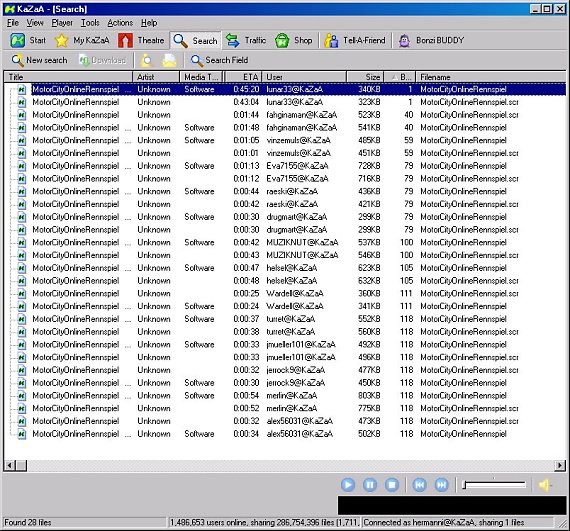Worm:W32/Benjamin
Summary
The Benjamin worm uses KaZaa Peer-To-Peer (P2P) network to spread. The KaZaa network allows its participants to exchange files with each other, using the special client software. The worm opens benjamin.xww.de Web-site to view an advertisement. The worm is written in Borland Delphi and is about 216 kilobytes long. The worm's file is compressed with ASPack file compressor. Besides the worm uses a decoy - it appends random data to its end that increases its size 2-3 times.
Removal
Based on the settings of your F-Secure security product, it will either move the file to the quarantine where it cannot spread or cause harm, or remove it.
A False Positive is when a file is incorrectly detected as harmful, usually because its code or behavior resembles known harmful programs. A False Positive will usually be fixed in a subsequent database update without any action needed on your part. If you wish, you may also:
-
Check for the latest database updates
First check if your F-Secure security program is using the latest updates, then try scanning the file again.
-
Submit a sample
After checking, if you still believe the file is incorrectly detected, you can submit a sample of it for re-analysis.
Note: If the file was moved to quarantine, you need to collect the file from quarantine before you can submit it.
-
Exclude a file from further scanning
If you are certain that the file is safe and want to continue using it, you can exclude it from further scanning by the F-Secure security product.
Note: You need administrative rights to change the settings.
Technical Details
Execution
When the worm's file is started, it shows a fake error message: Error Access error #03A:94574: Invalid pointer operation File possibly corrupted. Then it copies itself into Windows System directory as EXPLORER.SCR and creates two keys in the System Registry:
- [HKEY_LOCAL_MACHINE\Software\Microsoft\Windows\CurrentVersion\Run] "System-Service"="C:\\WINDOWS\\SYSTEM\\EXPLORER.SCR"
- [HKEY_LOCAL_MACHINE\Software\Microsoft] "syscod"="0065D7DB20008306B6A1"
This way, the worm makes sure that it is always executed when Windows starts.
Propagation (P2P)
The worm spreads only from and to computers where KaZaa network clients are installed. The worm reads the settings of the KaZaa client from the System Registry, creates the directory named \Sys32\ in Windows Temp folder and makes this directory visible to all clients of Kazaa network. The worm then fills this directory with its copies with various names which are taken from the list inside the worm's body. The list contains numerous titles of popular software, movies, games and music, and some commonly used search words. For example, this is only the part of the list with titles starting with 'A' letter:
- ...
- A.I-Artificial Intelligence- divx -full-downloader
- A.I-Artificial Intelligence- Filme -full-downloader
- ABeautifulMind
- AbsoluteZero-installer
- acdsee4
- ACDSeePowerPackRetail-installer
- Adobe InDesign 2.0 Build 416 -full-downloader
- Adobe Pagemaker -full-downloader
- Adobe Photoshop 6.0 -full-downloader
- Adobe Photoshop update (6.1) -full-downloader
- Adobe-Streamline-installer
- Adress Genie 4.0-full-downloader
- After Dark Deluxe-Bildschirmschoner-full-downloader
- Age of Empires 2- Games -full-downloader
- Age of Empires 2 Gold +Strat.Comm.-Games-full-downloader
- Age of Empires 2 Gold +Strat.Comm.-Spiel-full-downloader
- Age of Empires 2-Spiel-full-downloader
- Age of Empires Screensaver
- Age of Empires-Games-full-downloader
- Age of Empires-spiel-full-downloader
- Age of Mythology - Games -full-downloader
- Age of Mythology (Beta) -full-downloader
- Age of Mythology-installer
- Age of Wonders II The Wizard#39s-installer
- Airxonix -full-downloader
- AirxonixGeschicklichkeit
- Alarm Stufe Rot 2 -full-downloader
- Alarm Stufe Rot 2 Yuris Rache -full-downloader
- Alfred Hitchcock - The Final Cut - Games -full-downloader
- Alice-full-installer
- Alien vs. Predoator 2-Games-full-downloader
- Alien vs. Predoator 2-Spiel-full-downloader
- Aliens versus Predator 2 -full-downloader
- Aliens Versus Predator 2-installer
- Aliens versus Predator -full-downloader
- AliZaoua
- All Serials
- All Serialz
- Allout-Games-full-downloader
- Almost Famous-Komödie-Filme-full-downloader
- American McGee#39s Alice-Games-full-downloader
- American McGee#39s Alice-spiel-full-downloader
- American Pie 2 -divx-full-downloader
- American Pie 2- Filme -full-downloader
- American Pie 2-divx-full-downloader
- American Pie -divx-full-downloader
- Anam
- Anarchy Online-Games-full-downloader
- Anarchy Online-Spiel-full-downloader
- Animal
- Anno 1503 (Beta) -full-downloader
- Anno 1503- Games -full-downloader
- Anno 1503-Spiel-full-downloader
- Anno 1602 Königs Edition Classic- Games -full-downloader
- Anno 1602 Königs Edition Classic-Spiel-full-downloader
- Anstoss 3 -full-downloader
- Anti Hacker-Program 2002-full-downloader
- Appz
- Aquanox -full-downloader
- aquanox-full-downloader
- Aquanox-full-instaler
- ArmySargeHero
- ARX Fatalis-installer
- ARXFatalis
- Asheron#39s Call 2-installer
- Assessment Center-full-downloader
- Astalavista
- AsterixundOberlix
...

The worm spreads in the following way: a KaZaa network user searches for any file (for example the file that has the 'game' string in its file name) in the KaZaa network and finds it on the list of accessible files from an infected computer. The user downloads this file and starts it, thus infecting his own machine.